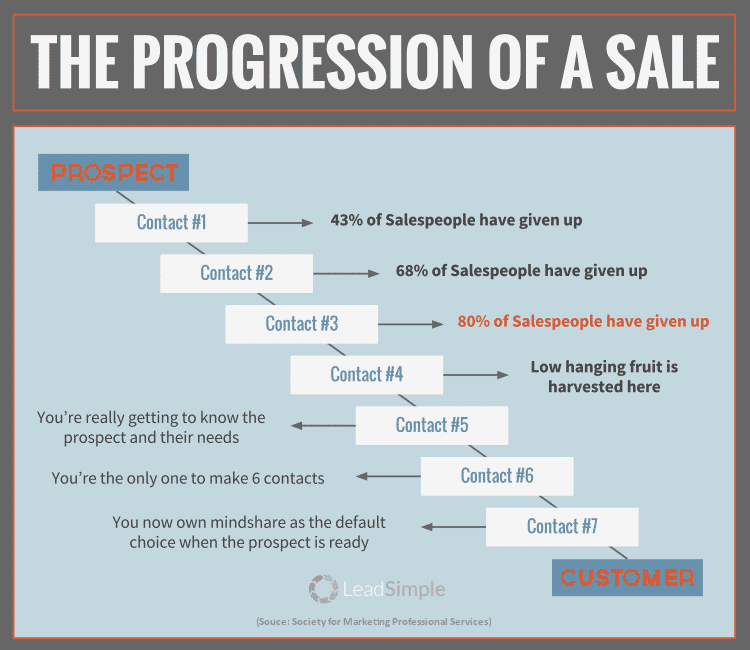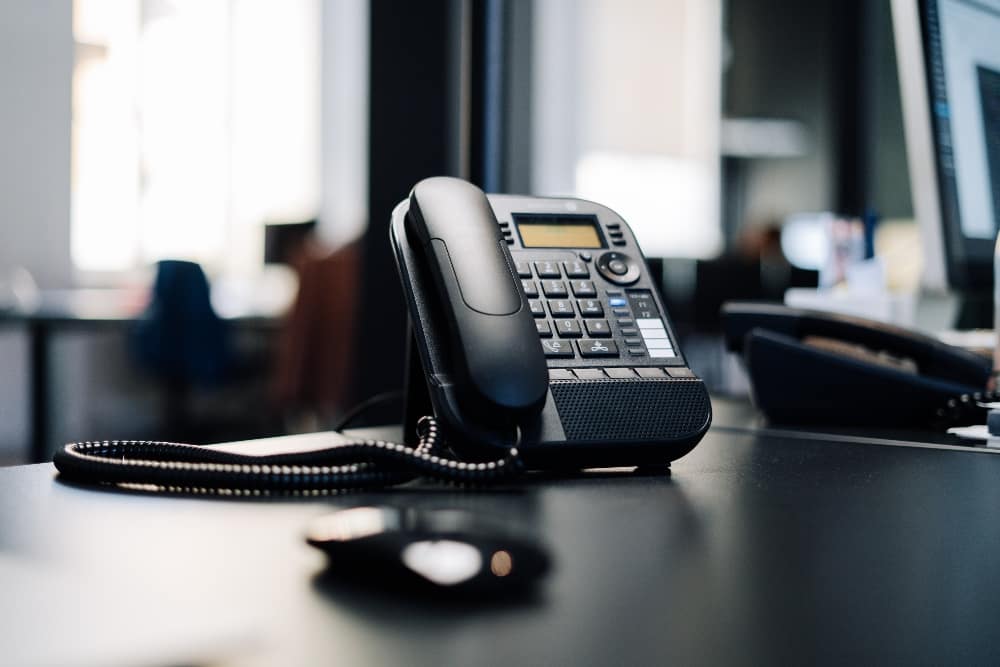This article has been contributed by Michelle Laurey.
If you’ve ever been responsible for closing sales, you know that the sales journey is rarely a direct move from first contact to close. There are calls to make, clients to meet, and deadlines to beat. That takes diligence and follow-up.

Lots of follow-up.
That includes the thank you note after an initial contact, and the calls to find out how your client is doing. But it’s more than just niceties.
Successful follow-up, the kind that boosts sales, requires a carefully crafted strategy flexible enough to tailor as you go but solid enough to obtain consistent results.
You have to effectively gauge where any individual customer is in their journey and meet them at each step along the way.
When done right, an effective follow-up strategy seems almost effortless. After all, it’s an art. Like all talented artists, a successful sales professional must learn the basics and then infuse their approach with a personal flair.
In order to do that, you must build rapport. This is best done in layers, like a painting, through successive steps that lead the customer to say yes to your proposal.
It’s a dance of continual action and interaction that never fully ends even after you close. However, it doesn’t have to be a slow dance — as long as you have a plan of action before taking that first step.
How a Successful Follow-Up Strategy Boosts Sales
In a busy world with so many distractions, people respond well to feeling valued. Dedicated follow-up is the answer to common frustrations around being left hanging or undervalued.
Keeping connected to your customers through a series of sales calls and platforms allows them to get answers, creates an emotional bond, and provides a higher level of service.
Would you rather deal with someone who’s impersonal and hasty or a rep who takes the time to get to know you and address your concerns?
Follow-ups are necessary and beneficial if you want a successful sales career. They benefit you by boosting your initial sales to new customers, plus they are essential if you want to keep established customers coming back for more.
A follow-up strategy is crucial for sales for a range of reasons.
- People are too busy to web hop or call multiple sales reps and companies looking for a product or service. You have to go to them.
- For every service provider, there are dozens of others vying for the prospect’s attention. While the number of deals closed after one contact is practically zero, the first vendor to contact a client is nine times more likely to eventually land the sale if they persist.
- Emails and other marketing materials get lost along the way. How many customers have you left sitting with unanswered questions, or with no way to say yes?
- People like to feel valued, and checking back with them shows them that they matter.
- Rather than taking more time to finalize a sale, properly implemented follow-up strategies actually save time and reap faster results.
Technology makes the art of follow-through so easy that, with the above in mind, there is no excuse for neglecting it. It becomes not a question of why, but a statement of why not.
Follow-Up Stats That May Surprise You
If you’re able to close a sale after just one contact, consider yourself lucky. Even the most gifted sales professional must doggedly chase leads and make multiple outreach efforts before they seal the deal.
Image source: leadsimple.com
Let’s look at some data:
- Around 80 percent of sales are only finalized after at least five follow-up calls.
- 63 percent of leads you talk to today won’t make a final decision for up to three months after your initial contact.
- Up to 20 percent won’t make any decision at all for a full year.
No one has the time to wait around for that.
However, almost half of all salespeople give up after the first follow-up call. This results in a staggering 98 percent loss of potential revenue because only two percent of sales close after one contact.
You can reduce the amount of time from first contact to close without slacking on your service or pressuring customers by creating an effective follow-up strategy.
6 Quick Steps to Follow-Up Success
All smart business moves require a plan of action that takes you from Point A to Point B by the fastest, most sustainable route.
Here are six proven strategies that will boost your sales and bring success over the long haul.
1. Establish a Workflow
Just as a website owner will create a content calendar in order to ensure that timely, updated material is available to their visitors, so must a sales professional establish a timeline for follow-ups.
Identify patterns
First of all, analyze your typical sales routine to detect patterns and trends.
For example, if your normal turnaround time from contact to close is two months, try making three additional contacts per month in order to reduce the average.
Next, analyze your sales history to determine other patterns like peak sales times or response to seasonal events. Plan during slowdowns and implement during peaks. Test and retool as needed.
Know Your Target Audience
You should also know your ideal buyer persona or target audience as well as possible.
This will help you to time your workflow and refine your approaches so that you can reach your audience more decisively during the sweet spot that falls between invasive and inactive.
Initial Contact
Use automated platforms such as email to enact your initial contact, tailoring content with each successive interaction to reflect where the customer is on their journey.
Call To Action
Make sure to include a clear and decisive CTA. Follow up with any response immediately.
Schedule Follow-Up
If your first contact is by phone or in person, set a definitive date for your follow-up call or contact. You could also provide a realistic deadline for responding in order to create urgency.
Post-Sale Thank You
When the sale is finalized, make sure to send a thank you note. This is better than a call or an impersonal email. It’s something tangible that they can see and hold, and it’s more personal than an auto-generated email.
2. Personalize Your Message
Before you make your first sales call, your marketing department or company leaders have defined a target market and created an ideal customer persona.
Your role as a salesperson is to craft an effective message and channel it to the persona you’re targeting.
Each follow-up call or contact allows you to get to know the customer and their pain points better. The same goes with analyzing metrics.
Use each new insight you gain to provide a more personal service that allows every customer to feel like they matter.
In general, every buying decision takes an effort on the part of the customer and the sales agent.
Identify emotional triggers that help your customers make decisions faster. This will make your job easier and allow the customer to feel better about their decision to purchase from you.
You’ll start the customer relationship off with positive feelings and reduce buyer’s remorse at the end of the process.
3. Mind Your Metrics
No two industries are alike. Just as individual companies have different missions and goals, sales cycles vary from industry to industry.
That’s why it’s important to devise a follow-up strategy that’s supported by technology. Practices like A/B testing will show you which approaches work best.
Defining and tracking key performance indicators (KPIs) provides feedback about the effectiveness of your approach, while web optimization ensures that your messages are reaching and attracting the right audience.
For example, the bulk of your sales prospects will involve outbound sales. These can be divided into hot or cold leads.
Obviously, hot leads are ready to buy much sooner than someone who shows little to no interest. Let the information you gain through data analysis guide your efforts and approach.
Data mining and analysis will also provide valuable feedback that will help you refine your approach before the next call.
With this type of technology, you’ll be able to use trends to your advantage, know which potential customers will need a little more time and effort, and when your existing customers are most likely to make an additional or supplementary purchase.
4. Build Interest and Desire
Features are nice. They create interest by telling customers about specific facets of your product or service. But, if you want to close deals, you have to point out the benefits of doing business with you.
In other words, one component tells what your product does while the other tells the customer what it can do for them. Knowing the difference is how you build desire, and it takes time.
Interest is piqued when a potential customer first becomes aware of your product. Each contact after that should lead your customer through the stages of their journey in a way that converts their interest to an intense desire to buy whatever you’re selling.
Use the features of your offering to attract interest during the initial sales process and then rely on enumerating your product’s benefits to advance their decision to purchase.
Eighty percent of your total revenue will come from existing customers, and it costs less to convert people who already know and trust you. Follow up after the initial sale to encourage customer loyalty and garner repeat or additional sales.
This is another area where personalization adds value. When you have an established relationship with a customer, you have a deeper understanding of their needs. This will cut the amount of time and effort needed to complete a sale.
However, anticipating a need or recognizing an opportunity to add on to an existing order requires follow-through. Benefits usually provide an answer to the customer’s questions.
5. Go That Extra Mile
One of the beast ways to beat the competition is to add value to your initial proposition. Follow-through is the ultimate in going the extra mile when it’s done right.
Use follow-up calls or emails as an opportunity to provide additional Information that will increase enjoyment or produce the information necessary to convert a maybe to a yes. This will result in a faster turnaround.
It’s also a great way to upsell or get your customer to consider complementary products.
Choose times that are convenient for your customer. This will ensure that you’ll have the time to make a personal pitch and address any lingering questions or concerns.
6. Practice Persistence and Patience
When I first started out in sales a million years ago, the conventional wisdom stated that quantity can make up for quality. All I had to do was patiently make 100 cold calls and at least one of those calls would result in a successful close.
The idea was that sales was a numbers game that would finally result in a win by the law of averages alone. It was a depressing and frustrating time in my career.
Fortunately, we know now that sustainable salesmanship involves more than just casting a wide net and hoping to bag a couple of fish.
It requires strategically sending out signals to a carefully selected pool of prospects, knowing how the buyer’s journey works, and creating a plan to nudge your prospects forward at each stop along the way.
This means being patient and persistent when it comes to engaging leads and following up with them during the process and after the conclusion of a sale.
Learn not to take no for an answer, but also know when to give up. Keep the prospect in mind for another launch or a more favorable time.
Not only should you have knowledge of the features and benefits of your product, you should also learn how to match these advantages to specific customer pain points.
Develop passion about your product and display that enthusiasm in a way that’s absolutely contagious to your clients.
Lastly, you need to be persistent and patient.
Create a sense of urgency without resorting to hard sells or misinformation, display authority, and express compassion.
Then, persistently work to cultivate an atmosphere of trust and reciprocity that benefits you and your client.
Final Thoughts
With the aid of technology, the art of the follow-up is easier and less time-consuming than ever. Each time you find a way to make your outreach efforts more streamlined and efficient, you increase the chances of facilitating a successful close.
However, follow-up is about more than making deals or improving revenue. It’s about connecting with customers in a meaningful way.
No matter how long you’ve been involved in sales or the makeup of your client base, following up helps build a foundation for these important relationships.
It is a skill that can be fine-tuned with practice and implemented with finesse once you know why and how it’s done.
Each of the above steps will allow you to reach out and establish bonds with new clients while better serving your existing customers.
—
About the author: Michelle Laurey works as a VA for small businesses. She loves talking business and productivity, and sharing her experience with others. Outside her keyboard, she spends time with her Kindle library or binge-watching Billions. Her superpower? Vinyasa flow! Talk to her on Twitter.



